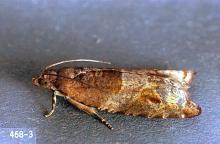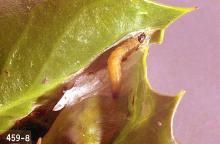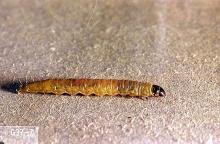Rhopobota naevana ilicifoliana
Pest description and crop damage The adult holly bud moth is a mottled brown and black insect with a wingspan of approximately 0.5 inch. The larvae are greenish-brown with dark heads and about 0.5 inch long. The larvae roll and web leaves. Another name for the holly bud moth is blackheaded fireworm. It also feeds on cranberry, blueberry, apple, and cherry.
Biology and life history This insect overwinters as eggs which hatch in spring at which time the new caterpillars feed on buds. Older caterpillars feed on leaves, first webbing them together. The feeding damage includes rolled leaves, holes, and blackened tissue, including tip dieback. The caterpillars generally pupate in leaves on the soil although pupae can be found on occasion within the rolled leaves while on the plant. The moth generally emerges in June and then lays eggs on the leaf underside. There are two generations a year. Other hosts include apple, blueberry, cherry, Crataegus, Fraxinus, Ilex, Prunus, Pyrus, Sorbus, Spiraea, Syringa, and Vaccinium.
Management-cultural control
Hand-pick larvae when found in rolled leaves. One cultural control for this pest is to collect and dispose of the fallen leaves to reduce successful emergence from the pupae.
Management-chemical control
See:
Chemical Control of Nursery Pests
Do not spray holly in bloom. Apply when new growth is about 0.25 inch long and before blossoms open. Spreader sticker may be needed.
For more information
Johnson, W.T. and H.H. Lyon (1991), Insects That Feed on Trees and Shrubs, 2nd ed., Cornell University Press (p. 206).
PNW Nursery IPM: Holly bud moth (http://oregonstate.edu/dept/nurspest/holly_bud_moth.htm)




